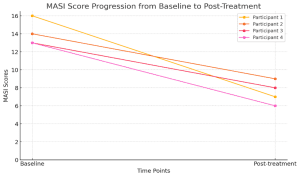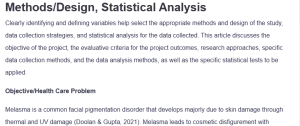Methods/Design, Statistical Analysis
Clearly identifying and defining variables help select the appropriate methods and design of the study, data collection strategies, and statistical analysis for the data collected. This article discusses the objective of the project, the evaluative criteria for the project outcomes, research approaches, specific data collection methods, and the data analysis methods, as well as the specific statistical tests to be applied.
Objective/Health Care Problem
Melasma is a common facial pigmentation disorder that develops majorly due to skin damage through thermal and UV damage (Doolan & Gupta, 2021). Melasma leads to cosmetic disfigurement with negative effects on the patient’s quality of life and mental and emotional health, leading to anxiety and depression (Chen et al., 2023). Various first-line treatment modalities, including topical agents such as topical hydroquinone, are used to manage melasma. However, such treatments are limited in their effectiveness in clearing hyperpigmentation associated with melasma with a high rate of recurrence (Ko et al., 2023). On the other hand, emerging treatments such as laser therapies have shown increased efficacy in managing dermal pigmentation, especially in high melanin skin types (Garg et al., 2024). This has sparked interest in exploring these alternative treatments for hyperpigmentation conditions. The proposed project examines the effectiveness of pico laser treatment in reducing hyperpigmentation among women with melasma.
Evaluative Criteria
The two major variables for this project are pico laser therapy as the independent variable and reduction of hyperpigmentation in women with melasma as the dependent variable. The major indicators for the action of the independent on dependent variables include the change in pigmentation intensity on the melasma area, changes in skin color quality, patient satisfaction and quality of life with pico laser treatment. These indicators can be measured using the Melasma Area and Severity Index (MASI) and Melasma Quality of Life Index (Sarkar et al., 2019) to determine the effectiveness of the pico laser treatment in reducing hyperpigmentation.
Research Approaches
The project will employ a mixed methods approach to research. This involves the use of quantitative and qualitative research approaches. The qualitative research approaches will be used to collect and analyze quantitative data for objective measurement of changes in hyperpigmentation and quality of skin color with treatment as indicated by the MASI tool. The qualitative research approaches will be used to analyze qualitative data on patient satisfaction and quality of life with treatment and treatment outcomes. Such data include personal experiences before and after the treatment, views on changes in cosmetic configuration, and quality of life associated with the treatment.
Data Collection
Quantitative data will be collected from MASI scores with pre-pretreatment and post-treatment. The data will be collected at various points throughout the 6-month period the project will be running. MASI scores effectively assess melasma severity and changes with treatment (Sarkar et al., 2019). Conversely, qualitative data on patient satisfaction and quality of life with pico laser treatment will be collected at the end of the project. The tools include interviews and the Melasma Quality of Life Index (Sarkar et al., 2019). These tools ensure the patient experiences with the pico laser treatment, and perceptions on quality-of-life outcomes with changes in melasma pigmentation can be collected to reflect levels of patient satisfaction and the impact of pico laser therapy on quality of life.
Data Analysis Methods
The quantitative and qualitative data collected will be analyzed using statistical methods and thematic analysis. The major statistical data analysis methods for deduction in pigmentation severity scores and changes in skin color quality include paired sample t-tests to compare pre- and post-treatment MASI scores. Thematic analysis will be used to identify and interpret themes in the qualitative data (Kiger & Varpio, 2020), which can help determine the levels of satisfaction and quality of life with pico treatment for melasma-related hyperpigmentation.
| Participant | Baseline MASI Score | Post-treatment MASI Score |
| 01 | 16 | 7 |
| 02 | 14 | 9 |
| 03 | 13 | 8 |
| 04 | 14 | 6 |
Conclusion
Assessing the effectiveness of pico laser treatment in reducing hyperpigmentation in women with melasma requires collecting and analyzing both quantitative and qualitative data. The appropriate research approaches and data collection and analysis strategies will ensure the effectiveness of pico laser treatment is measured objectively and subjectively.
References
Chen, W., Wan, Y., Sun, Y., Gao, C., & Li, J. (2023). Prevalence of depression in melasma: A systematic review and meta-analysis. Frontiers in Psychiatry, 14, 1276906. https://doi.org/10.3389/FPSYT.2023.1276906/BIBTEX
Doolan, B. J., & Gupta, M. (2021). Melasma. Australian Journal of General Practice, 50(12), 880–885. https://search.informit.org/doi/abs/10.3316/informit.188969926936982
Garg, S., Vashisht, K. R., Garg, D., Oberoi, B., & Sharma, G. (2024). Advancements in laser therapies for dermal hyperpigmentation in skin of color: A comprehensive literature review and experience of sequential laser treatments in a cohort of 122 Indian patients. Journal of Clinical Medicine, 13(7), 2116. https://doi.org/10.3390/JCM13072116/S1
Kiger, M. E., & Varpio, L. (2020). Thematic analysis of qualitative data: AMEE Guide No. 131. Medical Teacher, 42(8), 846–854. https://doi.org/10.1080/0142159X.2020.1755030
Ko, D., Wang, R. F., Ozog, D., Lim, H. W., & Mohammad, T. F. (2023). Disorders of hyperpigmentation. Part II. Review of management and treatment options for hyperpigmentation. Journal of the American Academy of Dermatology, 88(2), 291–320. https://doi.org/10.1016/J.JAAD.2021.12.065
Sarkar, R., Ghunawat, S., Narang, I., Verma, S., Garg, V. K., & Dua, R. (2019). Role of broad-spectrum sunscreen alone in the improvement of melasma area severity index (MASI) and Melasma Quality of Life Index in melasma. Journal of Cosmetic Dermatology, 18(4), 1066–1073. https://doi.org/10.1111/JOCD.12911
ORDER A PLAGIARISM-FREE PAPER HERE
We’ll write everything from scratch
Question
Week 5: Assignment – Methods/Design, Statistical Analysis
Assignment Prompt
Submit 2-3 pages describing the Methods/Design and Statistical Analysis that you will use in your project. Use the evidence from the peer reviewed articles that you have critically appraised and synthesized. Follow APA format and cite references. Include the following:
- Describe the evaluative criteria (indicators or variables) to be addressed in answering each evaluation question.
- Describe the research approaches to be used to answer each question and why they are appropriate to the evaluation questions posed.
- Describe in specific detail how data will be collected related to each of your evaluative criteria/indicators. Discuss exactly how the data be collected, when, and by whom. Describe any data collection tools in terms of their development and appropriateness in answering the evaluation questions. Provide information on validity and reliability of tools, if available. Explain why the data collection methods are appropriate to the research approach, type of data, and purpose of the evaluation.
- Describe how you will analyze the data, including specific statistical tests to be used. Include dummy data tables if applicable to show how you will display your findings.
Methods/Design, Statistical Analysis
Expectations
- Length: 2-3 pages
- Format: APA 7th ed.
- Research: At least two peer reviewed reference within the last 5 years



